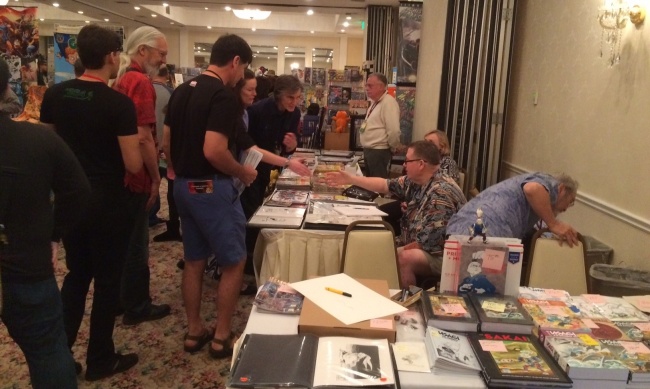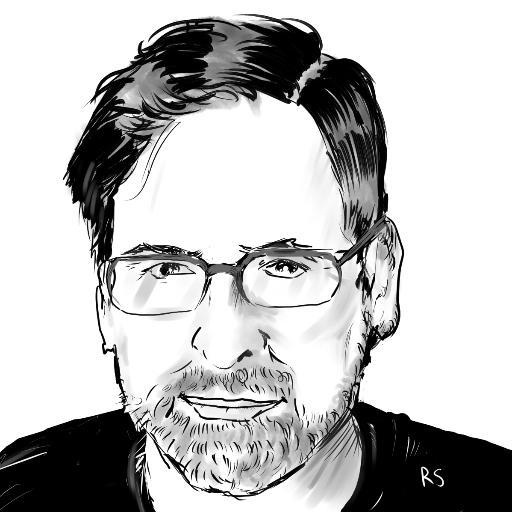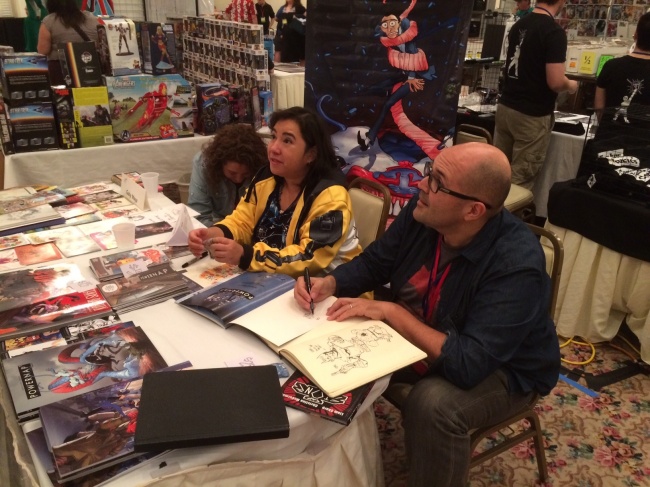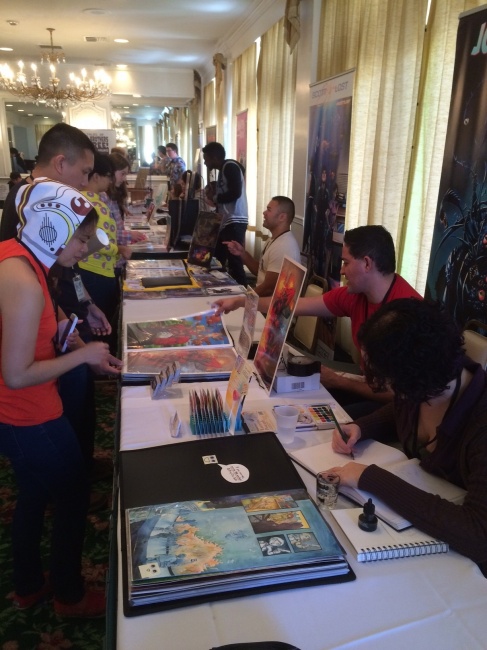And then there’s the show where I spent this past weekend: San Diego Comic Fest. Now in its fourth year, Comic Fest dispenses with all the extraneous diversions to focus on the core of the fan experience: camaraderie and pure love of the comics art form. At the same time, it operates at a different level from self-consciously arts-and-indie small press shows.
Instead of chasing the new and shiny, Comic Fest triumphantly embraces the past. Anyone who had attended a comic con in the 1970s would recognize it instantly, right down to most of the (now older) attendees and guests. It is a nostalgia-oriented show, but not because it is exclusively focused on the past. In fact, there were quite a few newer works and young creators around, and the programming reflected everything from memories of Forrest Ackerman to a lecture on Afrofuturism.
No, Comic Fest was nostalgic for a purer form of nostalgia. And that fact ironically places it at the center of one possible future of comics culture.
The Other San Diego Con. Comic Fest was held in a handful of conference rooms in a corner of the expansive, 60s-era Town and Country Resort in San Diego’s Mission Valley, a long trolley-ride from the bustling Gaslamp District where SDCC takes place. Because of the spread-out nature of the facility, it’s hard to say how many people attended, but it never felt crowded. The dealer’s room, featuring two or three dozen vendors selling collectibles and art, would fit comfortably in one of the smaller panel rooms of the San Diego Convention Center, with plenty of room to spare. About 30 artists were packed into Artist’s Alley on the 9th floor of an adjoining structure. There were four main tracks of programming from 10am-6pm on each of the three days of the show, with separate rooms dedicated to art and digital workshops. Small footprint, big impact. Despite the small scale, Comic Fest featured a stellar guest list for fans of just about every aspect of comics. The guests of honor were renowned graphic novelists Bryan and Mary Talbot, who came over from England. Classic talents like William Stout, Mike Royer and Scott Shaw mingled with contemporary favorites like Liam Sharp and Eric Shanower. There were best-selling science fiction authors Greg Bear, Jonathan Mayberry and David Brin, comics historian Trina Robbins, faculty members from San Diego State, and a half dozen local bands to provide after-hours entertainment. One highlight of the diverse programming was a set of panels moderated by comics historian Gerard Jones dedicated to the origins of DC Comics, featuring Nicky Wheeler-Nicholson (granddaughter of the original founder, Malcom Wheeler-Nicholson), Harry Donenfeld (grandson and namesake of one of the men who pried the business away from Wheeler-Nicholson shortly before the company published Action Comics #1), and Laura Siegel, daughter of Superman co-creator Jerry Siegel. As a comics-business geek, I was in heaven.Staying on Mission. Speaking personally, I could hardly imagine a show better targeted to my own interests (and the San Diego sunshine didn’t hurt either), but if this doesn’t sound like everyone’s idea of a great time, that seemed perfectly ok with the organizers. The goal of this event was to target a certain fan demographic and serve them better than a larger show, and they clearly succeeded.
Is the model sustainable? As of now, I have only anecdotal reports from exhibitors and artists who said they did “great” or “well enough,” especially considering the low cost of tables.
In terms of the con itself, showrunner Mike Towry said that previous shows had attracted about 2000 people but he wouldn’t have a final attendance count until later in the week. That would tell the tale of whether the show was slightly profitable, a wash, or a slight loss. Certainly it didn’t seem like a huge moneymaker for anyone. Labors of love rarely are.
Back to the Future. In my book Comic-Con and the Business of Pop Culture, I laid out a bunch of different scenarios for the future of comics. One of them, which I called “Ghost World,” envisioned what might happen if mass media and the entertainment industry ever lost interest in comics. In that case, fandom would retreat toward a culture position similar to poetry or jazz – a niche for enthusiasts and connoisseurs, respected but not especially popular, with events taking place on a more intimate scale.
Obviously, considering that San Diego Comic Fest took place over the weekend when Deadpool set box office records, we are very far from that scenario being the dominant narrative. But it’s interesting that today’s comic culture is vibrant enough that even the past occupies a comfortable niche in the present, and might possibly have a real future, miles away from the crowds and noise of mainstream 21st century fandom.
The opinions expressed in this column are solely those of the writer, and do not necessarily reflect the views of the editorial staff of ICv2.com.
--Rob Salkowitz (@robsalk) is the author of Comic-Con and the Business of Pop Culture.








